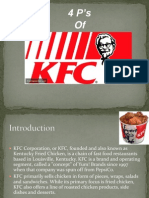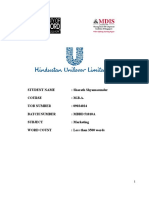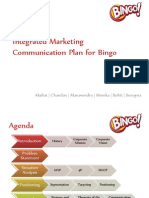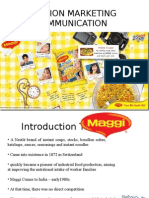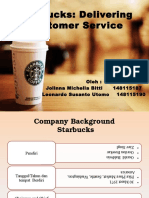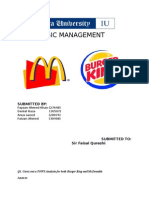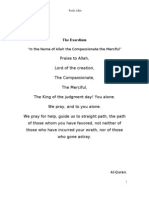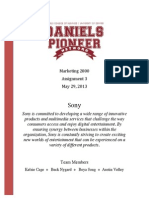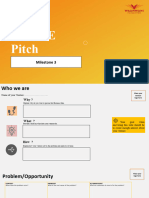Indomie - Paper
Indomie - Paper
Uploaded by
Hari Zainuddin RasyidCopyright:
Available Formats
Indomie - Paper
Indomie - Paper
Uploaded by
Hari Zainuddin RasyidOriginal Description:
Copyright
Available Formats
Share this document
Did you find this document useful?
Is this content inappropriate?
Copyright:
Available Formats
Indomie - Paper
Indomie - Paper
Uploaded by
Hari Zainuddin RasyidCopyright:
Available Formats
Porters Generic Strategy The overall cost leadership is the most appropriate strategy for Indomie (mie goreng)
as the dominant market leader in response to the price war competition in the market with their follower and challenger. To compete effectively in price-sensitive market such as instant noodles, Indofood concentrates upon achieving the lowest costs of production and distribution costs with setting its prices at a lower level than its competitors (Kotler, 2003). This is the choice of generic strategy in order to maintaining Indofood as the market leader in instant noodles industry with slightly increase according to the objective in year of 2006, which is 40 percent Indomie as the highest sales percentage brand in Indofood. According to what stated in Wilson (1997, p.329), rather it provides management with an opportunity to learn how the triad of technology, management and labor can be used effectively. Therefore, instead of the large scale economies of Indomie production, stricter controls also are being implemented including better production management to reduce cash tied up in inventory and others of operating costs. After restructuring the operations, from focus on divisional profitability to core product profitability, the management will work in better coordination. In addition, focusing distribution in potential area also will help the cost cutting but still capture the wide market coverage. Market Targeting Indomie in general or Indomie (Mie goreng) fried noodle as the substitute product of staple food, has concentrated its product based on the demographic segmentation of people aged older than 5 years old we categorized for all ages, from children, teenager to older. This flavour of Indomie has an extremely wide range of segments overall attractiveness, because of the full market coverage in undifferentiated marketing strategy with its mass production product, mass distribution, and mass promotion of one product for all consumers (Kotler, 2003). It is the approach carried out in the cost leadership strategy of Porter (1980). Company set about broadening the consumer base for the product (Broadbent, 1981), such as Indomie (mie goreng) can be targeted for all ages, from segment with lower income to high income people. But looking
back to the market trend of 2004, the competitors win from narrowing the market segment with the low price. Therefore, the next year 2005-2006 market will be more targeted for lower income class. In addition, it is targeted for peoples consumption who lives in urban city and rural, especially with high level of consumption in urban city with having the meal between the busy times, for student and working people audience. Besides that, in global market, main target is the Asian countries which noodles as the choices as the staples food. Positioning Strategy Indomie has benefited nature in the consumers heart and mind, because its existence as the jargon of the instant noodles as a household name in Indonesia since 20 years ago. Thus, Indomie (Mie goreng) fried noodles offering the instant noodle with the strong and emotional message with customer to occupy a distinctive place in the mind of the target market (Kotler, 2003). In order to build the positioning strategy, Indomie (Mie goreng) fried noodle will come with a worthwhile difference to promote, with the benefit and communicable of the brand positioning, which is Smart Price for Anywhere, Anytime, and Anyone. In the year of 2005-2006, Indomie uses prices and functional as its basis for its dominant in the market place. As competition increases and the product already know well by Indonesians consumers, an elaboration associate themselves more clearly and an introduction of a new price (Hooley & Saunders, 1993). Elaboration of Indomie in appreciating the loyalty consumer with concerned about the social wellbeing of consumers that Indomie (mie goreng) can be functioned in various occasion/festival, time and consumers. Introduction also becomes important for establishing the new valuable price of product in the market. For example, the campaign promotion in occasions such as Mother's Day or religious festival, for example people can buy more Indomie (mie goreng) because of low price during fasting month and Hari Raya, it shows that Indomie can exist in all of this special time. Marketing Mix Product Strategy
In the level of SBU strategies, we identify the products/markets competitive advantage and attractiveness using two of the portfolio analysis. This BCG portfolio (see Figure 1) analysis will shows the current position on the growth share of Indofood (mie goreng) fried noodle based on market growth rate to measure market attractiveness, and market share as company strength in the market (Jain, 2000, pp. 249-50). The next analysis is the product life cycle (PLC) to see the competitive condition from the stage based on the time, sales and profit in order to decide the marketing strategies ( Jaim, 2000).
Figure 1 The BCG Portfolio Matrix of Indomie (Mie Goreng) Fried Noodle As we can see from the Fig.1 & 2, the product of Indomie (Mie goreng) Fried Noodle has been achieve the maturity stage, since facing the new growing number of competitors, the position has been shifting from stars to cash cow, because the sales and market growth has been decrease. Based on Kotler (2004), the strategy that will be appropriate is the product modification, thus we are going to change the products characteristics. There are two strategies that we are focusing, firstly, the strategy of quality improvement of the raw material such as high quality wheat flavour with the implementation of the food fortification such as protein, severe malnutrition and vitamin A in Indomie (mie goreng) fried noodles. Secondly is the strategy of the style improvement to increase the attractiveness of the product. We still keep on our original flavour. The additional ingredients
and health food label will be added in the packaging. The extra ingredients such as small pieces fish crackers will make the instant noodles more attractively served.
Figure 2 The Stage of Indomie (Mie Goreng) Fried Noodle in Product Life Cycle (PLC) Pricing Strategy The competition price becomes big challenge for Indomie to make price strategy for next year marketing plan. The company is competing with rivals especially Wings food, whose Mie Sedap noodle brand is 20 percent cheaper than Indofood's main Indomie. For the same brand and flavour of fried noodle, Indomie selling price is Rp. 910 and Mie Sedap is Rp. 650. There are others competitors such as Salami or Mie Selera Rakyat who penetrate the market in lower price. Our market in maturity stage characterized by pricing defensively in order to protect our market share, thus we are going to introduce lower priced fighting brand than our competitors (Kennedy & Kiel, 2000). Related to our quality product, we will offer the greater benefit for consumers with the super-value strategy (see Figure 3). The price will be cut for 30%, so that the new price will be set Rp.625 in the market. Based on the market research and others health
food issues, Indomie (Mie-goreng) fried noodle more valuable based on the quality, reliability, and availability.
Figure 3 The Price-Quality Strategy In addition, Indomie (Mie goreng) fried noodle also use the priceadjustment strategy to regulate the prices, for low-cost shoppers or in other words who lives in poverty line and still can afford the Indomie product for consumption. Some of the strategies are quantity discount such as buy 5, 1 free and with special offer valuable pricing for household in eye-catching package and seasonings from that alluring pricing strategy plan, we are optimistic to achieve the objectives for increase the minimum 2% sales, and gross profit. Placing Strategy Distribution plays big role to make the brand positioning market strategy for the high availability in anywhere and anytime to be realized. The availability can be achieved by ensuring the freshness and availability of its products across the country, through instead of strategic manufacturing locations and extensive distribution network. The structure will be the same for indirect channel through the division of Indofoods distribution intensively (Kotler, 2003). The strategy is more focus in developing the distribution network to work more closely with retailers, responding faster to their feedback. Based on the growing numbers of modern retail market shops in urban city, we are going to develop the channel distribution to the hypermarkets, supermarket, mini market, such as new entrants retailer Giant supermarket
and 24 hours shops Circle K. However, developing and get closely channels of distribution for low income segment people in urban areas and rural areas in particular also important, with thewarung (kiosks) and toko kelontongan (independent food stores or provision stores) remain the backbone of Indonesias processed food distribution, servicing 65% of the population. Looking forward based on the demographic trend opportunities, to support the distribution, we are going to expand the divisions sales force focusing on a wider spread of retailers on Java Island, but still expand into the wide region in all around Indonesia. In addition, we also develop the service food capabilities for institutional customers including restaurant and small warung food (small local restaurant). Promotion Strategy Response to the issues, opportunities and threats, start from the mid-year 2005 and 2006 will be full of intensively of promotion and advertising. Indofood will spend big budget for support the Indomie (Mie-goreng) fried noodle promotion strategy. It will be allocated with the promotion mix strategy, using the methods of advertising through the television, mass media, billboards, signs and posters, the other is the sales promotion with demonstration and exhibits (Jain, 2000). With the largest market share and product quality of instant noodles, Indomie (Mie goreng) fried noodle must generally spend more on advertising to maintain its share and the need to convince the consumer that the product is unique and reliable (Worked book, 1984). The most important in doing the promotion is the message that we want to deliver to our target market. In order to capture the target market and positioning of our brand, we choose to use the slogan Smart price for anywhere, anytime and anyone. This is so due to the fact that adverts are done smart choice for consumers benefited from more valuable price that can be present in any occasions and festivals. In this line of commercials, consumers and target customers are made to see ever so glaringly that Indomie noodles is concerned about the social wellbeing of consumers and the consumer itself. Such as, in the commercial TV of the Valentine period shows an availability of delicious Indomie noodles
as a lovers' delight, or during the Moslems fasting month festival, people have more lists in their household budget, Indomie (mie goreng) fried noodle will be the smart choice for the consumers. Indomie (mie goreng) fried noodle also attempt to use comparative advertising, which is Indomie will be compared with the most competing brands, not to mention. Moreover, sponsorship advertising corporate with the media TV show will be considered as the functional image publicity. Moreover, the tools than Indomie will use for the sales promotion is the premium offer, as already stated in the pricing strategy. The consumer can buy some packs of Indomie in one attractive package with offering others Indofoods household in low-valuable price. All of these will be supported by outdoor advertising in the form of billboards. Controls Indofood has high awareness to the controlling and evaluating , because it is a large company. In controlling and evaluating the marketing plan of 2005-2006, Indofood generally do all the types of controls, those are annual plan control, in sales analysis, market share and financial analysis. Also others are the profitability control, efficiency control and strategic control (Kotler, 2003, p.685). All the control is integrated with all the division inside Indomie, supported by the SAP software system and management system that can analysis the situation market and sales among all the region. In order to measure effectiveness of the plan, a measurement should be made and performed against the objectives set, example, profit and sales. (Band & Scanlan, 1995, pp102-104) Quantitative and Qualitative measure should be made with consideration came from customer on company image and perception. Moreover, during 1 year period of marketing year 20052006, the analysis and report will generate the quantitative measure based consideration on: 1. Total unit sales by monthly sales report 2. New customer per four quarters (every 3 months) 3. Market share movement per four quarters 4. Profit and Profitability per four quarters, integrated prepared by sales and accounting division. 5. Product sales differentiate by market segment per four quarters
The qualitative measure will include consideration on: 1. Brand loyalty 2. Brand Equity (brand awareness and product image) 3. Customer service enquiries volume 4. Technical support 5. Retailer Promotion Moreover beside our on evaluating we on the qualitative analyze and the quantitative competitor performance product, must also
performance, especially Mie Sedap, who steals 10% of the market share of Indomie in 2004. This is in order to meet with our objectives we must not lost the battle in the next term year of marketing. Contingency Plans Contingency plan is proposed according to the issues that might be happen in range time of the marketing year of 2005 2006. First, the foreign currency risk. With the terrorism terror attack and the unstable of economic, if the exchange rate of US to Rupiah become more drop. We are getting complicated in make the marketing plan, because the budget allocation for the marketing mix must be reduced. The other issue is about the oil prices, because after climbing about 40 percent last year, oil prices have continued to gyrate widely over the past two weeks. Even, the government would not increase the oil price, but we have to do prepare with the prevention plan (Sumual, 2004).Thus, if the macro environment situation become more complicated that we forecasted before in the marketing plan. There are some strategy changes in our contingency plan that we have to consider according to the marketing plan. In case of the raw material and operating cost will increase significantly. We will cut the budget for production cost, especially from the raw material such as wheat flour and packaging. The improvement of products attractiveness still set in the plan. The Tangible strategy will be the priority. Regarding pricing strategy Indofood in general and Indomie in particular, we must sustain the price below market rate which cant be compromise also which set in Rp. 625. But, we can consider looking for others quality raw material which is cost below the fixed cost has settled before. It become difficult for keep on the reducing the price strategy. Automatically,
the others household products will increase also include the instant noodles products. So that, looking to our competitor, especially Mie Sedap (wings Food) obviously can not maintain their low price in the market. Eventually, the distribution has to be selective in developing the channel distributions consider to the region. And, for the promotion strategy we can reduce the intensity and frequently of the advertising and sales promotion. Conclusion Looking to the market trend, there are significant of market growth and volume. Through the macro environment analysis, the price legal environment and economic both giving some opportunities and also challenges. In the year 2005-2006, we are going to face threats from competitors, the product of Mie Sedap from Wings Food become more highlighted, because of the prices 20% below Indomie, and able to take chances 10% in the market share. However, Indomie have many strength and opportunities as the market leader and its experience able to attack back the competitors. Meanwhile, the increase of wheat price and health consciousness also becomes issues. Based on the SWOT analysis looking into the market and macro environment, the product of Indomie (Mie goreng) fried noodle will combine all the marketing mix strategy in a year ahead. Indomie still win in emotional image and brand loyalty through their target market. Develop the quality product, Reducing the price, develop on distribution channel, aggressive advertising and premium offer become the strategy for next year. With this strategy, Indomie (Mie goreng) fried noodle optimist to increase the sales and profits at 2% rate minimum, besides stealing back the market share that has fell down in 2004. For the prevention and evaluation, the contingency plan and control has been prepared for the marketing plan 2005- 2006.
You might also like
- Integrated Marketing Communication of DominosDocument23 pagesIntegrated Marketing Communication of DominosSrishti MangalNo ratings yet
- Case Study Nintendo SwitchDocument6 pagesCase Study Nintendo SwitchErica QuialNo ratings yet
- Plumbing Company Marketing PlanDocument20 pagesPlumbing Company Marketing PlanPalo Alto Software100% (3)
- Indomie SwotDocument1 pageIndomie SwotAingtea010100% (1)
- Markman Final Papers (Nissin Instant Mami)Document24 pagesMarkman Final Papers (Nissin Instant Mami)Arianna Maouna Serneo Bernardo100% (1)
- Blue Ocean StrategyDocument6 pagesBlue Ocean Strategypriyank1256100% (1)
- Domino's New Marketing PlanDocument15 pagesDomino's New Marketing PlanCarina Ng Ka Ling77% (13)
- Sony MM ReportDocument4 pagesSony MM ReportAqsaNo ratings yet
- Foundr - The Ultimate Guide To Growing Your Online Business Using Instagram PDFDocument62 pagesFoundr - The Ultimate Guide To Growing Your Online Business Using Instagram PDFEstherTan100% (2)
- Indomie PricingDocument3 pagesIndomie PricingKumar ShashwatNo ratings yet
- Marketing Strategist of PT Indofood CBP Sukses Makmur TBKDocument8 pagesMarketing Strategist of PT Indofood CBP Sukses Makmur TBKchaaNo ratings yet
- Market Analysis Indofood IndonesiaDocument17 pagesMarket Analysis Indofood IndonesiaIrwan Setyawan100% (1)
- Strategy WalmartDocument25 pagesStrategy WalmartABHIRUP ANANDNo ratings yet
- Sales Promotion Plan On: College of Business Administration Department of Marketing ManagementDocument35 pagesSales Promotion Plan On: College of Business Administration Department of Marketing ManagementDanielle Joyce Blanco MaglaqueNo ratings yet
- Kentucky Fried Chicken KFC Marketing Mix Four PsDocument25 pagesKentucky Fried Chicken KFC Marketing Mix Four PsRahul Singh RathoreNo ratings yet
- MARKETING of Dominos PizzaDocument45 pagesMARKETING of Dominos PizzaAMIT K SINGHNo ratings yet
- Consumer Behaviour InterviewsDocument6 pagesConsumer Behaviour InterviewsAmeya Pai AngleNo ratings yet
- Consumer Market Segmentation: Prepared By: Jastine EscoteDocument35 pagesConsumer Market Segmentation: Prepared By: Jastine EscoteJohn DelacruzNo ratings yet
- Syeda Zauwia RiazDocument15 pagesSyeda Zauwia RiazkarimanrlfNo ratings yet
- The Coke and Pepsi Rivalry - ModifiedDocument19 pagesThe Coke and Pepsi Rivalry - ModifiedSoham PradhanNo ratings yet
- Papa John'sDocument12 pagesPapa John'sshielamae100% (1)
- KissanDocument3 pagesKissanVikas RastogiNo ratings yet
- Marketing PlanDocument59 pagesMarketing PlanSharath Shyamasunder75% (4)
- Rural MarketingDocument35 pagesRural MarketingdarshanNo ratings yet
- Ben and Jerry Situation Analysis 1Document30 pagesBen and Jerry Situation Analysis 1api-238369021100% (1)
- Imc Plan OreoDocument11 pagesImc Plan OreoApril Jade Ruiz100% (1)
- Operations Assignment 2Document10 pagesOperations Assignment 2munish05No ratings yet
- FMCG MarketingDocument68 pagesFMCG MarketingPalak Jha100% (1)
- Tiktok Best Practices: App CampaignDocument55 pagesTiktok Best Practices: App Campaignvia.de.juneNo ratings yet
- Kodak & Fuji Rivalry (MK)Document13 pagesKodak & Fuji Rivalry (MK)Manoj KumarNo ratings yet
- The Noodle MarketDocument27 pagesThe Noodle MarketRavi PanaraNo ratings yet
- Case Study On SamsungDocument7 pagesCase Study On SamsungAtin SoodNo ratings yet
- Quiz 1 Entree19 Farah Andayani 29320028Document30 pagesQuiz 1 Entree19 Farah Andayani 29320028Farah Andayani RNo ratings yet
- Marketing Plan - MR Dorasami Final2013Document23 pagesMarketing Plan - MR Dorasami Final2013Tishta BachooNo ratings yet
- Syllabus & Sap MM5003 - : Marketing ManagementDocument19 pagesSyllabus & Sap MM5003 - : Marketing ManagementTumpal SimatupangNo ratings yet
- FPC Pinehill Presentation 2020-06-29Document26 pagesFPC Pinehill Presentation 2020-06-29Anto BrilliantoNo ratings yet
- IMC Plan-Bingo - Group NDocument32 pagesIMC Plan-Bingo - Group NManavendra Roy Choudhury100% (1)
- To Launch Bata BiscutDocument33 pagesTo Launch Bata BiscutmajicloverNo ratings yet
- Plan-ACI Pure Instant NoodlesDocument17 pagesPlan-ACI Pure Instant Noodlesradi1924No ratings yet
- Analysis of Brand Awareness, Brand Images, Halal Labels and Products Towards Purchase Intention of Wardah ConsumersDocument7 pagesAnalysis of Brand Awareness, Brand Images, Halal Labels and Products Towards Purchase Intention of Wardah ConsumersInternational Journal of Innovative Science and Research TechnologyNo ratings yet
- IMC Mountain Dew Group 4Document3 pagesIMC Mountain Dew Group 4shibaniniNo ratings yet
- Syndicate 3 - Shopclues Logistics v2Document16 pagesSyndicate 3 - Shopclues Logistics v2Bobby Mandala PutraNo ratings yet
- Homework 2Document4 pagesHomework 2Tường ViNo ratings yet
- KFCDocument5 pagesKFCMadhuri PatelNo ratings yet
- Chapter 4 - Conducting Marketing ResearchDocument7 pagesChapter 4 - Conducting Marketing ResearchTường ViNo ratings yet
- Maggi Ads Comparative StudyDocument26 pagesMaggi Ads Comparative StudyPriyanshu SharmaNo ratings yet
- Blackberry IMC PlanDocument105 pagesBlackberry IMC PlanNadia Mercado100% (5)
- MINISO INDIA Mudt Sharma PHGFB 1935Document1 pageMINISO INDIA Mudt Sharma PHGFB 1935Mudit SharmaNo ratings yet
- 7 ElevenDocument9 pages7 ElevenArman TNo ratings yet
- IMC PlanDocument6 pagesIMC PlanRizwan Ahmed KhanNo ratings yet
- Health Drink - MKTDocument46 pagesHealth Drink - MKTGunjan BhattNo ratings yet
- Nintendo MMDocument9 pagesNintendo MMrizkyadhim_918349864No ratings yet
- Mcdonalds IndiaDocument28 pagesMcdonalds IndiaianlasradoNo ratings yet
- Starbucks Delivering Customer ServiceDocument18 pagesStarbucks Delivering Customer ServiceMadhur PahujaNo ratings yet
- Canon Company - INTERNET MARKETINGDocument12 pagesCanon Company - INTERNET MARKETINGJunchen ZhouNo ratings yet
- Retail Management: Online Grocery Store: ShopeaseDocument31 pagesRetail Management: Online Grocery Store: ShopeaseVeerannaBhusannavarNo ratings yet
- What Is Market SegmentationDocument8 pagesWhat Is Market SegmentationMuhammad Hassan SohailNo ratings yet
- Integrated Marketing Communication in CementDocument2 pagesIntegrated Marketing Communication in CementShimondiNo ratings yet
- Miniso EXPANSIONDocument3 pagesMiniso EXPANSIONRahul SardarNo ratings yet
- McDonalds & BK Case Study 2Document10 pagesMcDonalds & BK Case Study 2Babar100% (2)
- MC VS BKDocument10 pagesMC VS BKdanialrazaNo ratings yet
- Perceived Value - A Critical Examination of Definitions, Concepts and Measures For The Service IndustryDocument13 pagesPerceived Value - A Critical Examination of Definitions, Concepts and Measures For The Service IndustryHari Zainuddin RasyidNo ratings yet
- IMC - The Importance of Message ConsistencyDocument2 pagesIMC - The Importance of Message ConsistencyHari Zainuddin RasyidNo ratings yet
- IMC - The Importance of Message ConsistencyDocument2 pagesIMC - The Importance of Message ConsistencyHari Zainuddin RasyidNo ratings yet
- Honey Care Africa's Tripartite ModelDocument11 pagesHoney Care Africa's Tripartite ModelHari Zainuddin RasyidNo ratings yet
- Indomie - PaperDocument9 pagesIndomie - PaperHari Zainuddin Rasyid0% (1)
- Final Project Rooh AfzaDocument39 pagesFinal Project Rooh Afzaadeel73% (11)
- Marketing Proposal SonyDocument11 pagesMarketing Proposal Sonykecage100% (2)
- Strategic Marketing ManagementDocument13 pagesStrategic Marketing ManagementAngelo VillalobosNo ratings yet
- Growth Hacking HandbookDocument131 pagesGrowth Hacking HandbookMarco Santonocito100% (8)
- BVG INCube 4Document23 pagesBVG INCube 4Netaji BhosaleNo ratings yet
- Virgin Mobile CaseDocument32 pagesVirgin Mobile Caseshagun khandelwalNo ratings yet
- Writing A Business Plan: Study Guide For Module No. 3Document7 pagesWriting A Business Plan: Study Guide For Module No. 3Mirasol ManaoatNo ratings yet
- Business in A Box SampleDocument23 pagesBusiness in A Box SampleNelson Alele100% (1)
- Mushroom Cluster Business Plan For To Become Agripreneur: Presented ByDocument17 pagesMushroom Cluster Business Plan For To Become Agripreneur: Presented ByMohitSharmaNo ratings yet
- IMC ProjectDocument16 pagesIMC ProjectKusal JayawardenaNo ratings yet
- Business Enterprise SimulationDocument12 pagesBusiness Enterprise SimulationCha Eun WooNo ratings yet
- Marketing ManagementDocument328 pagesMarketing Managementlatsek50% (4)
- Submitted by Qaisar Shahzad Submitted To Khurram Amin Roll No MCOF19M008 Program Session 2019-2021Document10 pagesSubmitted by Qaisar Shahzad Submitted To Khurram Amin Roll No MCOF19M008 Program Session 2019-2021Faaiz YousafNo ratings yet
- Final Project Technopreneurship FormatDocument6 pagesFinal Project Technopreneurship FormatJulius BoitizonNo ratings yet
- Ignite Milestone 3Document20 pagesIgnite Milestone 3ILEENVIRUSNo ratings yet
- Tutorial Letter 101 (Both) For MNM2602 2020Document36 pagesTutorial Letter 101 (Both) For MNM2602 2020SleepingPhantoms100% (1)
- Lesson 4Document39 pagesLesson 4phython 1109No ratings yet
- Executive Summary: Marketing ManagementDocument15 pagesExecutive Summary: Marketing ManagementusmanmasoodkhanNo ratings yet
- Entrepreneurship S5 SBDocument167 pagesEntrepreneurship S5 SBngaboalain180No ratings yet
- Lesson 2 Entrep The Market TodayDocument61 pagesLesson 2 Entrep The Market TodayCARL JAMESNo ratings yet
- B To B Marketing-1Document119 pagesB To B Marketing-1AyushNo ratings yet
- Assignment 02 (Entrepreneurship - Feasibility Report)Document10 pagesAssignment 02 (Entrepreneurship - Feasibility Report)usama ilyas100% (1)
- Entrep Module 8Document50 pagesEntrep Module 8JOVY ASTRERO100% (1)
- Business Plan SampleDocument22 pagesBusiness Plan SampleGift SimauNo ratings yet
- W8 Product Devt Operations Financial PlanDocument61 pagesW8 Product Devt Operations Financial Plannax vienNo ratings yet
- Writing InstrumentsDocument85 pagesWriting InstrumentsSahil50% (2)
- ThesisDocument105 pagesThesisisaac.krizelaclairemNo ratings yet
- Mco-06 Solved Assignment For Mcom: Like Our Facebook Page For UpdatesDocument14 pagesMco-06 Solved Assignment For Mcom: Like Our Facebook Page For UpdatesAjayNo ratings yet














